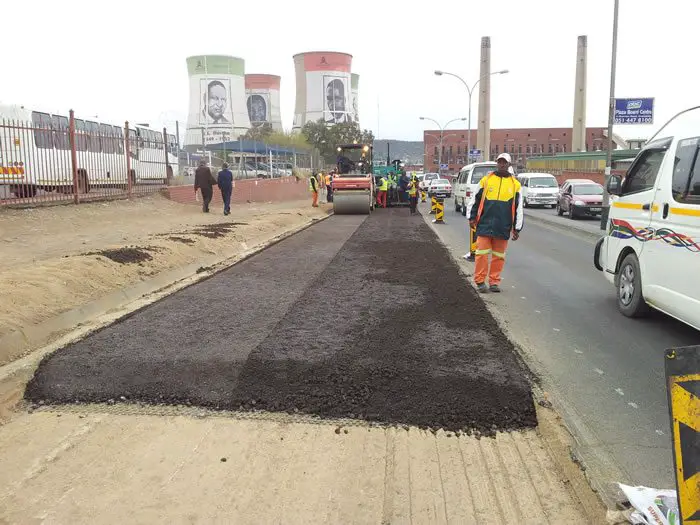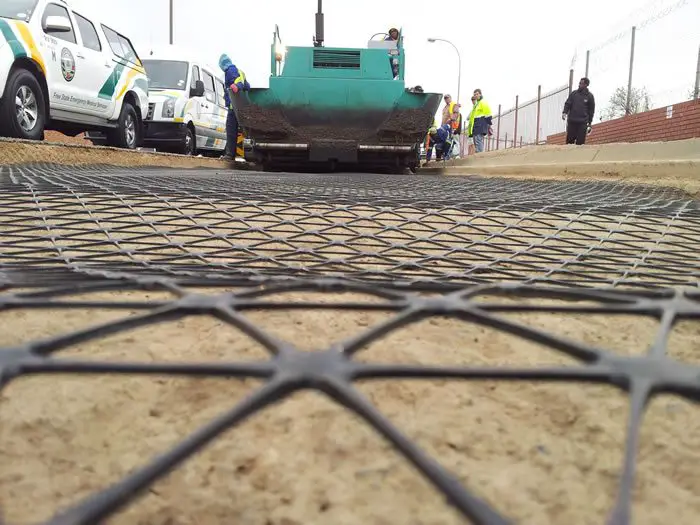The Tensar design was both sustainable and environmentally friendly by recycling the existing pavement asphalt surface and reusing the existing base materials. The innovative pavement rehabilitation solution conquered many challenges, including reducing depth of pavement reconstruction, improving traffic and pedestrian safety, reducing imported materials along with a reduction in exported material waste and no encroachment on existing services.
The anticipated programme for the construction of a conventional deep pavement is anticipated in excess of 5 weeks per section, whereas the Tensar pavement optimisation solution was constructed in just over 1 week.
THE PROBLEM
Shallow services and utilities were located under the existing pavement asphalt which would need to be relocated or protected when using a traditional pavement design solution. The existing kerb levels were fixed so any solution needed to leave this in-situ. The road is located in a built-up and highly populated city centre. There was a need to minimise traffic and pedestrian disruption and environmental hazards such as noise, dust, construction traffic and-emissions.
THE SOLUTION
Tensar Technology was exploited to provide a proven, practical solution to the customer’s site-specific requirements. Recycling the existing pavement asphalt surface material and reusing the existing base material led to minimal wastage of material. To reduce the required pavement thickness the whole pavement structure was optimised by utilising a Tensar MSL™ (Mechanically Stabilised Layer) incorporating TriAx® geogrid below the bitumen stabilised base. This allowed the existing kerbs levels to be retained and avoided disturbance of underlying services. A key additional benefit included an accelerated contractor’s programme which enabled traffic to be diverted back onto the reconstructed highway 3 hours after pavement construction.
Bloemfontein is the capital city of the Free State Province of South Africa and one of South Africa’s three national capitals – the other two being Cape Town and Pretoria.
Conventional rehabilitation methods would have involved full depth reconstruction by excavating at least 700 mm of the highway and rebuilding with well-graded material. Unfortunately, the consultants discovered that the subterranean municipal services in Harvey Road and Hanger Street were located at a depth of just over 300mm. Due to the importance of these roads and the situation they had on-site with the services, traffic, pedestrians and limitations on construction traffic in the city centre, the engineers realised that conventional methods would not be sufficient.

The shallow services and utilities included electric cables, telecommunication cables and water pipes under the existing pavement. In particular, a very old lead-based water pipeline was located on some of the sections and disturbing this service would be detrimental to the project as fittings and couplings for the old service are no longer obtainable.
The cost to replace these services would in fact outweigh the cost of the whole project. The kerb levels and positions were fixed and the rehabilitation solution was able to be constructed within the confines of the existing highway width. This resulted in further savings in cost and time because no kerbs needed to be replaced with the exception of broken or missing kerbs.
Comment from Vonda Pretorius, Royal HaskoningDHV. “The TriAx used under the recycled base performed well under the moving tyres of the paver. In essence, the introduction of the geogrid compensated for the low bearing capacity of the underlying layers.
We were able to reduce the depth of the base layer and as result the rehabilitation cost of the project was reduced, saving time and money using Tensar Technology. We found that the installation of the geogrid on this project was the optimum solution to provide a safe, economical, environmental friendly and timeous project.”

